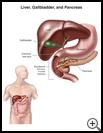
Gallbladder Drainage: Cholecystostomy
________________________________________________________________________
KEY POINTS
- Cholecystostomy is a procedure for putting a tube into your gallbladder to drain fluid.
- You may need this procedure if you have gallstones, swelling and infection, or a tumor that blocks the outlet of your gallbladder.
- Ask your provider how long it will take to recover and how to take care of yourself at home.
- Make sure you know what symptoms or problems you should watch for and what to do if you have them.
________________________________________________________________________
What is gallbladder drainage?
Cholecystostomy is a procedure for putting a tube into your gallbladder to drain fluid.
The liver and gallbladder are part of your digestive system. The liver makes bile that helps your body break down the fat in food. Ducts carry bile from the liver to the gallbladder and small intestine. The gallbladder is a small sac under your liver on your right side that stores bile.
When is it used?
This procedure may be done when the outlet of the gallbladder is blocked by a tumor or gallstone. Gallstones are hard stone-like objects that build up in the gallbladder. They may be as small as a grain of sand to as large as a golf ball. If stones completely block the gallbladder or bile duct, the flow of bile out of the liver can also be blocked. This causes swelling, irritation, and pain in your liver, your gallbladder, or both. If not treated, swelling can cause your gallbladder to burst, or you could get a serious infection. Both can be life-threatening.
Your gallbladder may need to be drained to reduce infection and swelling. This procedure will not cure tumors or stones, but it can relieve symptoms until surgery to remove the gallbladder can be safely done.
Ask your healthcare provider about your choices for treatment and the risks.
How do I prepare for this procedure?
This is usually an emergency procedure, so you may not be able to plan ahead.
- Plan for your care and a ride home after the procedure.
- You may or may not need to take your regular medicines the day of the procedure. Tell your healthcare provider about all medicines and supplements that you take. Some products may increase your risk of side effects. Ask your healthcare provider if you need to avoid taking any medicine or supplements before the procedure.
- Tell your healthcare provider if you have any food, medicine, or other allergies such as latex.
- Follow your provider's instructions about not smoking before and after the procedure. Smokers may have more breathing problems during the procedure and heal more slowly. It’s best to quit 6 to 8 weeks before surgery.
- Follow any other instructions your healthcare provider gives you.
- Ask any questions you have before the procedure. You should understand what your healthcare provider is going to do. You have the right to make decisions about your healthcare and to give permission for tests or procedures.
What happens during this procedure?
The procedure is done at the hospital. You will be given local or general anesthesia to keep you from feeling pain during the procedure. Local anesthesia numbs the part of your body where you will have the procedure. You may also be given a sedative to help you relax but you may be awake during the procedure. General anesthesia relaxes your muscles and puts you into a deep sleep.
Your healthcare provider will put a tube into your gallbladder through a cut in your belly. X-rays, or ultrasound are usually used to help place the tube. The tube will be connected to a drainage bag. You may need to have stones removed from the gallbladder when the tube is placed. The procedure usually takes about an hour.
What happens after this procedure?
You will stay in the hospital until your gallbladder is drained and your symptoms have improved, which may take a few days. You will very likely go home with the tube in place. This is a short term treatment and you will need to have your gallbladder removed when you are better and there is less infection and swelling in your gallbladder. You will be taught how to take care of the tube.
Ask your healthcare provider:
- How long the tube will be in place and if it will be removed
- How long it will take to recover
- If there are activities you should avoid and when you can return to your normal activities
- How to take care of yourself at home
- What symptoms or problems you should watch for and what to do if you have them
Make sure you know when you should come back for a checkup. Keep all appointments for provider visits or tests.
What are the risks of this procedure?
Every procedure or treatment has risks. Some possible risks of this procedure include:
- You may have problems with anesthesia.
- You may have infection, bleeding or blood clots.
- The intestine, gallbladder or other nearby organs could be injured.
- The bile may leak and cause swelling or infection inside your belly.
- Infection in the gallbladder may not be controlled or the tube may come out. Your provider may need to place another drain to treat the infection. You may need antibiotics.
Ask your healthcare provider how these risks apply to you. Be sure to discuss any other questions or concerns that you may have.

